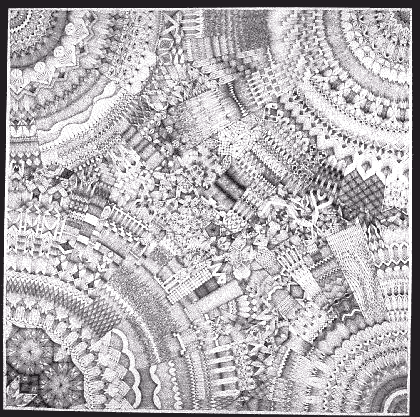B r e a k t h r o u g h s
Almost as soon as I reduced my technique to the making of one mark, I wanted the drawings to show the true sequence in which the marks were made. The first drawing that did this is the one which begins my diary, a square spiral done on 6 July 1970. More and larger spirals followed: Form is the Language of Time, the Calendars, as well as recent drawings like Adhesions and Wild (1999).
The first two Calendars (August 1970) were breakthroughs. Calendar 1 was the first time that the marks were organized into a series of repetitions, alternations, bisections and symmetry groups. In other words, my basic vocabulary crystallized in this drawing. Calendar 2 pushed this vocabulary into "grace space." It turned the formalism of Calendar 1 into the metaphor of human memory and foresight. It is still my favorite.
Recording the experience of time was my main interest back then. Thatís why music was such an important model. Yet even drawings with strict sequencing, like the Calendars, showed that ink stops time. Earlier marks co-exist on the paper with later ones. They can all be seen together, or even read in reverse order (e.g., following the spiral back from finish to start; a viewer often canít know which end is the beginning). In drawing, sequences always fade to coincidence, history foreshortens into structure, process becomes place. Timeís foreshortening seemed not so much a problem, though, as a magic trick, an illusion hiding a space where I could move freely. I quit insisting on visible chronologies and started exploring how time collapses into space, scattering symmetries around shifting axes of reflection.
Around the time of Calendar 6 I stumbled almost accidentally into the literature of particle physics. I had been vaguely interested in the smallest "bits" of matter since 1967. But I hadnít learned more about them and I barely remembered anything from my high school science classes. Reading Teilhard de Chardinís The Phenomenon of Man, which itself was a powerful experience, made me eager to know more about the fundamentals of time and space, matter and energy.
Time-order ambiguities were a key to Einsteinís relativity. The laws of Newton, Maxwell, Dirac and Heisenberg all treat past and future as interchangable. Symmetry and its breaking seemed to be a major theme of physics, somehow defining the properties of the universe.
"...I was immersed in Pythagorean fantasy, reading up on natural proportions such as Planckís constant, π, Hubbleís constant, the gravitational constant. I read an essay on Planckís constant written by Erwin Schrodinger that was so brilliant and vivid in its description of the geometry of elemental matter that I am still immersed in the subject. But since the quantum concepts of physics came into my head months after I had reduced my drawing to combinations of a single element, I canít say I do what I do because science says reality does it that way..." (Journal entry, 27 December 1971)
Nonetheless, I did start thinking of my ink mark as a "quantum" act caught in a web of symmetries and assymmetries. And just as modern science rejects the notion of an absolute metric for space and time separate from matter, I turned against "scaffolding."
My Calendars were built on "scaffolds": spirals drawn with pencil and compass. When I finished adding the ink marks, I erased the pencil lines. I had also begun making drawings based on grids ruled in pencil. (Grids have more ambiguous time-orders than spirals.) But using and then erasing pencil lines struck me as dishonest. It also imposed a geometry not immanent in the marks themselves. It was a kind of "action at a distance," a purely visual order that did not grow out of the mark-by-mark evolution of the drawing. So in the spring of 1972 I stopped using measured/ruled/pencilled armatures. It was a liberating decision that I never reversed.
Very quickly I saw that grids could be replaced by more general structures - arrays of cells, polygon tilings and froths. Spirals could be floppy, as in Form is the Language of Time. Geometry not only could be but, according to modern science, MUST be elastic, topological, based on similarities rather than equalities. This opened my mind to more dynamic forms: flows, decays, rips, shards, close-packings, eruptions, etc. These were more richly allegorical than the Euclidean motifs I had been using.
"I feel like the really great energy inside my head has almost connected with the paper receptor. I can imagine the complete closing of the circuit coming within a month: there are moments of contact, passages of complete synchronization already, some lasting minutes, a few lasting an hour or two. It is only a matter of patience in pursuit..." (Journal entry, 15 March 1972)
The "complete closing of the circuit" finally came in January 1973, with the series called Personal Domains of Freedom and Ecstasy. The title says it all. These are improvisations, dervish raptures. I cannot find words to talk about them. But the impulse seems to be the same as Keith Jarrettís completely improvised piano concerts (I did an album cover for him in 1972).

Personal Domain of Freedom & Ecstasy #2, 7-11 June 1973 (51 x 51 cm)
| Page 2 | Page 4 |